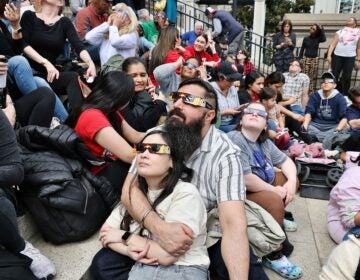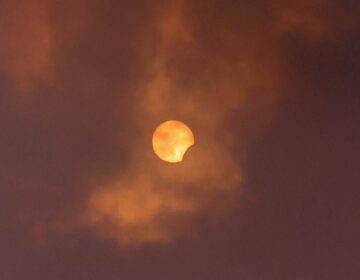May Day Alert!
Listen 00:06:33This Friday, May 1st is a cross-quarter day – halfway between the first day of spring and the first day of summer. It’s a day that has been marked by festivals and celebrations for centuries.
The month of April is filled with Outer Space Anniversaries;
• Original 7 American astronauts were chosen in 1959
• first human in space in 1961
• first test-firing of the Sat V first stage1965
• first spacecraft to orbit the moon in 1966 – Luna 10
• first space station Salyut 1 1971
• first space funeral 1997
• first space tourist 2001
Also, scientists have success with a new, more direct way to study exoplanets.
Image:Debivort on Wikimedia Commons
April 27, 2015
[Dave Heller] May Day celebrations go way, way back in history.
[Derrick Pitts] May Day, also known as Beltane is typically held on April 30 or May 1. It’s purpose is to welcome the arrival of spring and appeal to Gaelic gods and deities for good weather, and great success with the growth of crops and good luck and success with their animal stocks as well.
[Dave Heller] But indeed it is not the advent of spring, rather the cross-quarter day halfway between the start of spring and the start of summer on the calendar.
[Derrick Pitts] Yes, that is true it is that cross-quarter day halfway between the first day of spring and the first day of summer as we define it but some of these older cultures of northern Europe actually identify this day as the first day of summer. For example Shakespeare’s play, “A Midsummer Night’s Dream.” That doesn’t take place in July or August that really takes place in June and so that’s how it comes to be mid-summer for that play because the beginning of summer was identified as May Day rather than June 21.
Well, before bidding adieu to April, there are apparently several space firsts to note.
Yes, it is an interesting month because of the sort of first that happened in space exploration. The original seven American astronauts were chosen in 1959 in April. There is a pretty significant milestone in the U.S. The first human in space Yuri Gagarin, a Russian, his flight was fifty-four years ago in 1961. The first test firing of the Saturn V launch vehicle that actually carried Americans to the moon. That first test firing was in 1965, fifty years ago. It is such a powerful machine, it is hard to imagine it took place back then, what now seems like the dark ages but indeed that is what was happening. Then the first space craft to orbit the moon, “Luna Ten” was launched in 1966, the first space station “Salyut 1”. Again, a Russian space craft was in 1971, their second one, “Salyut 2 ” was in 1973, so we are actually up to the fourth space station now, if you also consider the Mir space station that came not long ago after those other two. The first space funeral took place in 1997, and this was actually an instance in which a number of very small capsules of the ashes of a number of deceased were actually launched into space.
I am curious has that event been replicated since?
Yes, indeed it has and there are two notable internments if you will in space. One is Gene Roddenberry, creator of “Star Trek” and also Eugene Shoemaker was an American geologist who was the person who taught all of the Apollo astronauts how to practice geology on the moon. One final major milestone of April is that the first space tourist, Dennis Tito, private citizen visited the Mir space station in 2001. The Mir space station, as previously stated, is a Russian space station actually, a Soviet space station and the way that Dennis Tito got to go was that he offered to pay for his trip. At this time the Russians did accept payment for private citizens to visit the Mir space station, and I believe Tito paid approximately twenty million dollars to make the trip.
Derrick, there’s a break-through in the way astronomers are detecting and analyzing planets outside our solar system.
Yes, there has been a big change. The change is how it is that we are able to collect information about extra-solar planets orbiting other stars. Previously, what we were doing was a lot of the inferential data collecting–figuring out what might be going on with these planets based on models that have been developed based on observations we’ve made of planets orbiting other stars. Some are based on what type of star it is and what could be expected for planets positioned at a certain distance and with a certain mass. However, the best way for us is to obtain information about luminous sources, even planets, is through spectroscopy. It has been very difficult to do spectroscopy of extra-solar planets because of two things: primarily, the fact that planets are so close to the their stars- it has been nearly impossible to differentiate between the light reflecting from a planets surface and the star itself as well as the tremendous difference that is involved. That eventually gets down to the fact that the measurements that we are trying to make are so incredibly tiny that factors in as well, but now a new method has been identified in which a very high resolution spectrograph mounted on a 3.6 meter telescope in Chile has been able to capture spectrum of one particular planet. That planet, 51 Pegasi b the first extra-solar planet discovered orbiting sun-like star back in 1995. This really does mark a milestone in our capability to analyze other extra-solar planets–sort of defeating all those other difficulties that have made it so hard before.
WHYY is your source for fact-based, in-depth journalism and information. As a nonprofit organization, we rely on financial support from readers like you. Please give today.




